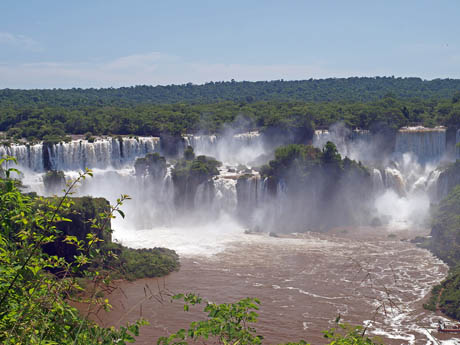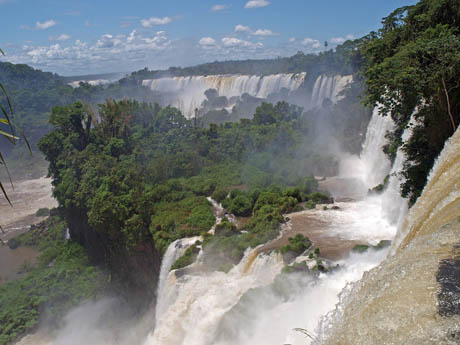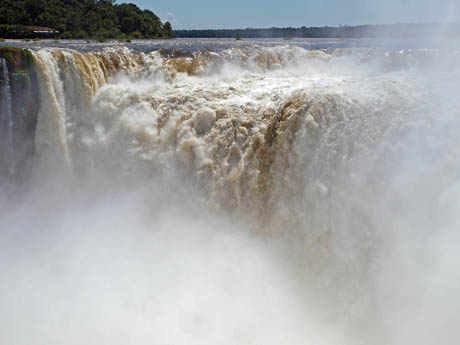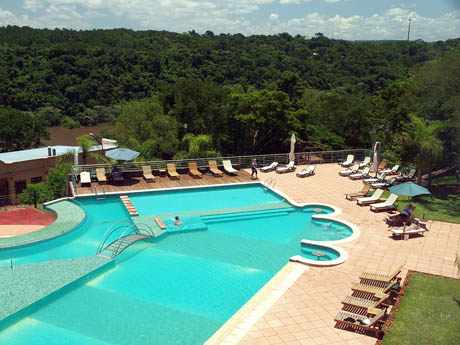Each year, thousands of people visit the Iguazu Falls , not only to see the spectacular waterfalls themselves, but also to enjoy the magnificent unspoilt environment which surrounds them. This is a subtropical jungle where you can find one of the most diverse ranges of flora and fauna in South America.
The Falls
The Iguazu Falls are higher than Niagara Falls and twice as wide. There are 275 cascades arranged in a horseshoe shape three miles wide which are fed by the Iguazu River. This unique geological oddity is the result of a volcanic eruption that left a huge mark on Earth. During the rainy season (November to March) the water flow can reach 12,750 cubic meters a second. The drop is on average 82 meters.

Facts and figures do nothing to describe the true splendour of the falls. This beautiful tropical location and the majestic beauty of the surging power of the river made Eleanor Roosevelt exclaim, "Poor Niagara!"
History
The name of the falls “Iguazu” comes from the Guarani language, meaning "big water." The first Spanish explorer to see the falls was Alvar Nunez Cabeza de Vaca in 1541.
Around the falls there are several historical and archaeological sites, including the ruins of a Jesuit mission, one of the first settlements of Christian Evangelism in South America.
In 1991, man harnessed some of the vast power of the falls with the construction of the giant Itaipu hydroelectric dam, a joint project between Brazil and Paraguay. The dam is open to the public and provides 12.6 million KW of electricity, which covers nearly 40% of the needs of Brazil and Argentina. One of the largest in the world, the dam is proudly claimed to be an engineering masterpiece.

Stunning ecosystem
The falls are part of a nearly virgin jungle ecosystem protected on both the Brazilian and Argentine sides with National Parks. Two thirds of the falls are on the Argentine side of the river where you can take a tour through the Iguazu National Park. Ideally, plan a whole day in the Argentine National Park to enjoy the wildlife fauna and flora.
How to visit?
You can visit the falls in a whirlwind trip, but many people opt for a tour of 3 days and 2 nights, so there is enough time to visit the Brazilian and Argentine sides and all of the different places to see.
The view from the Brazilian side gives a panoramic impression of the falls. There are helicopter tours from the Brazilian town of Foz do Iguaçu to see the falls, but they are causing damage to the fauna and flora in the National Park so many locals and ecologists advise not to take them.
There are boat trips which pass beside and under the falls. If you are a keen photographer, the best light is in the morning.
The Garganta del Diablo (Devil’s Throat) is where over 14 waterfalls tumble from more than 100 meters high with such force that a 30 meter long cloud of rain is created, often accompanied by a beautiful rainbow. The best place to see this is from the Brazilian side. For a closer look at the Devil’s Throat go through the subtropical forest of Iguaçu National Park up to the base of Floriano waterfalls and climb to the top of the falls or walk over the waterfalls Union. On the Argentine side of the Iguazu Falls, you can walk along a path built over the water to the Devil’s Throat. A raincoat is recommended, or you can go for a swimming costume as there are places where you can "swim" in the fine rain produced by the Iguazu Falls.

Downstream of the falls you can observe the Parana River junction and from this panoramic point you can see where the borders of Argentina, Brazil and Paraguay all meet up together.
When to go?
The best seasons to see the Iguazu Falls are the spring and the fall. The summer is tropical, so it is hot and very humid. In winter, the water level is lower. There are hotels on both banks of the river and there are many tours and excursions to explore the surroundings.

Pablo Polito from 01Argentina contributed text and the stunning images for this article. 01Argentina Travel Agency has provided hundreds of people over the last few years with tailor-made tours for visitors to experience the best of what the Iguazu Falls and their surroundings have to offer. To find out what he and his team can offer, get in touch:
- Tel: +54 11 4621 4725
- Website: http://www.01argentina.com

